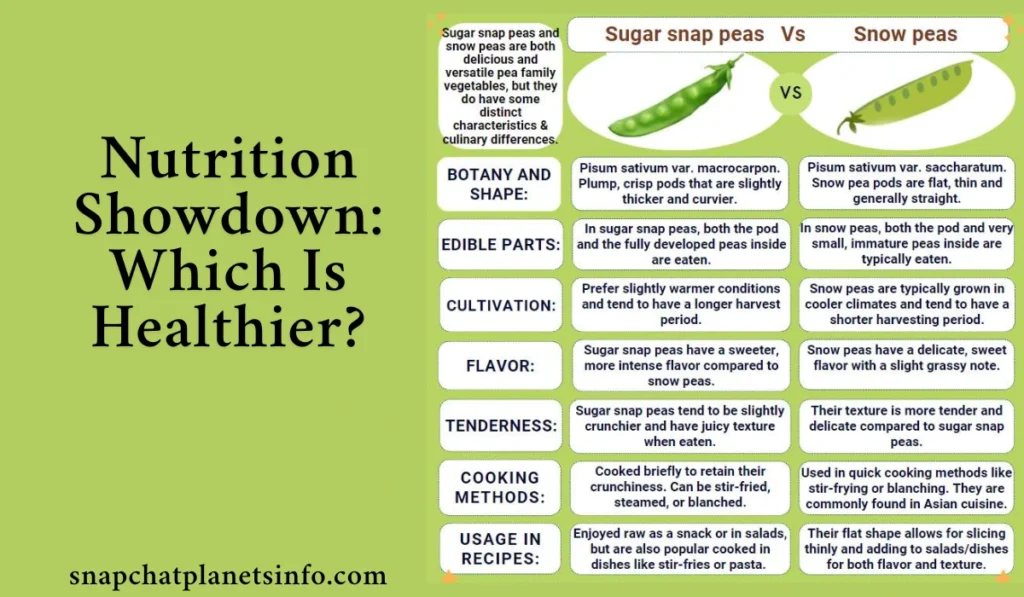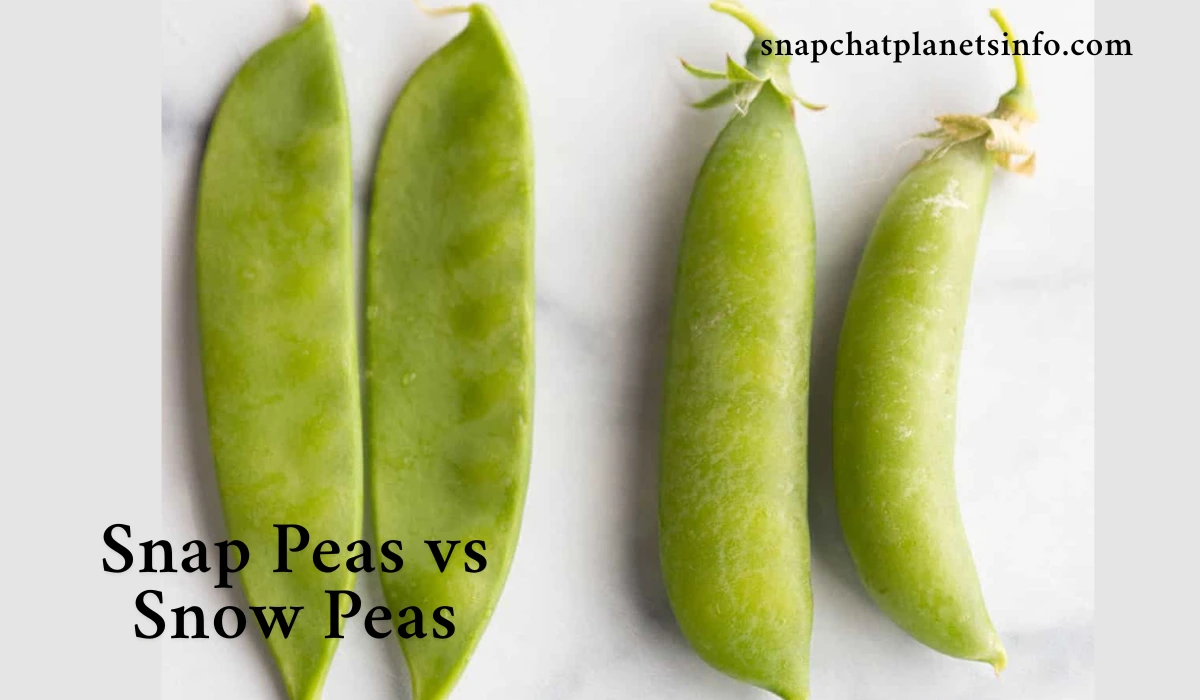When spring arrives, farmers’ markets begin to fill with fresh, green vegetables. Among the most popular are snap peas and snow peas. Though they look similar, these two pea varieties have unique differences. This blog will explore the topic of Snap Peas vs Snow Peas, comparing their taste, texture, nutrition, and uses. Whether you’re cooking a stir-fry or packing a healthy snack, knowing the difference can help you make better choices.
Snap Peas vs Snow Peas: Understanding the Basics
Both types of peas are part of the legume family. They grow in edible pods and are harvested while still young and tender. However, they come from slightly different varieties of the Pisum sativum plant. While snow peas have been cultivated for centuries, snap peas are a modern hybrid. Snap peas were developed in the 1970s by crossing snow peas with garden peas to get the best of both—sweet taste and edible pods.
Snow peas are also known as Chinese pea pods and are commonly used in Asian cooking. On the other hand, snap peas are often enjoyed raw due to their natural sweetness. In the debate of snap peas vs snow peas, the choice often depends on the recipe and your taste preference.
| Feature | Snap Peas | Snow Peas |
|---|---|---|
| Shape | Plump and rounded | Flat and thin |
| Flavor | Sweet and juicy | Mild and grassy |
| Texture | Crunchy | Crisp and tender |
| Best Uses | Raw snacks, salads | Stir-fries, steamed sides |
| Cooking Time | 1–2 minutes | 1 minute or less |
| Nutrition Value | Nearly identical | Nearly identical |
| Edibility | Entire pod edible | Entire pod edible |
| Storage | Up to 5 days refrigerated | Up to 5 days refrigerated |
Read more: Snap benefits ms
Comparing Shape, Texture, and Taste
To the untrained eye, snap peas and snow peas may look nearly identical. But once you examine them closely, the differences are clear.
Snow peas have a flat pod with tiny peas inside. Their shape is slender, and the peas are barely developed. In contrast, snap peas are plump and rounded, with fully formed peas you can see through the pod wall.
Snow peas are crisp and mild, while snap peas are crunchy and sweet. This sweetness comes from the garden pea genetics in snap peas, making them a favorite for snacking. Because of their distinct textures, these peas cook and taste differently in dishes. Understanding snap peas vs snow peas helps when planning meals, especially those requiring specific textures or flavors.
Nutrition Showdown: Which Is Healthier?

Both snow peas and snap peas offer similar health benefits. They are low in calories, high in fiber, and packed with vitamins and minerals. Here’s a comparison to show what 100 grams of each contains:
| Nutrient | Snap Peas | Snow Peas |
|---|---|---|
| Calories | 42 kcal | 42 kcal |
| Carbohydrates | 7.5 g | 7.5 g |
| Protein | 2.8 g | 2.8 g |
| Fiber | 2.6 g | 2.6 g |
| Vitamin C | 100% of DV | 100% of DV |
| Vitamin K | 31% of DV | 31% of DV |
| Folate | 10% of DV | 10% of DV |
| Magnesium | 6% of DV | 6% of DV |
| Manganese | 12% of DV | 12% of DV |
As you can see, both peas are almost identical in nutrition. That’s why the question of snap peas vs snow peas is often more about taste and texture, not health value. Both are excellent choices if you’re aiming to eat clean, lose weight, or add more fiber to your diet.
Health Benefits You Should Know
Both snap peas and snow peas support overall health. Vitamin C in both helps boost your immune system and skin health. Vitamin K plays a role in bone strength and blood clotting. These peas also provide antioxidants, including flavonoids and carotenoids, which help protect against chronic diseases.
Another key benefit is the fiber content. Fiber helps you feel full, supports digestion, and may reduce cholesterol levels. People trying to manage weight or blood sugar levels may benefit from eating peas regularly. So, in terms of snap peas vs snow peas, both are powerful allies in a healthy lifestyle.
Cooking and Preparation Methods
One of the biggest reasons people compare snap peas vs snow peas is to know which is better in cooking. Both peas are versatile and cook quickly. But their structure makes them more suitable for different types of dishes.
Snow peas are great in stir-fries. They cook fast and don’t become soggy. Just trim the ends and remove the string. You can boil them for a short time or sauté with garlic and soy sauce.
Snap peas are usually enjoyed raw. Their natural sweetness makes them perfect for salads or vegetable trays. They can also be lightly steamed or roasted. Like snow peas, you should remove the string and trim the ends before cooking.
In both cases, avoid overcooking. Too much heat can cause them to lose their bright color and crunch. Knowing how to prepare them properly can make a big difference in your dish.
Seasonal Availability and Storage
Snow peas and snap peas are available year-round but are best in spring and early summer. That’s when their flavor is freshest. When buying, choose peas with firm pods and bright green color. Avoid any that are wilted or discolored.
For storage, keep them in the refrigerator in a plastic bag. They usually last for up to five days. Do not wash them until you are ready to eat, as excess moisture can lead to mold. You can also freeze them after blanching for longer storage.
Are They Interchangeable in Recipes?
Yes, you can often substitute one for the other. But you must consider how they behave when cooked. Snap peas are sweeter and crunchier. Snow peas are flatter and less sweet but more tender.
If a dish needs a bright, crunchy bite, use snap peas. If you’re stir-frying or making an Asian-style dish, snow peas may be a better fit. In a salad, snap peas shine. For a light side dish, snow peas offer a gentle touch.
The snap peas vs snow peas debate is not about right or wrong. It’s about finding the right fit for your recipe and taste.
Read more: Longest snap streak
Cultural and Culinary Uses
Snow peas are commonly used in Chinese cuisine, especially in stir-fries and noodle bowls. Snap peas are popular in Western cooking, often eaten raw or with dips.
Both types of peas add vibrant color and nutrition to meals. Whether you enjoy snap peas vs snow peas, both bring freshness to the plate. In 2025, healthy eating trends are focusing more on whole, nutrient-dense foods. That’s why peas are growing in popularity again.
Frequently Asked Questions
Are snap peas sweeter than snow peas?
Yes, snap peas are generally sweeter due to their garden pea genetics.
Can I eat snow peas raw?
Yes, snow peas can be eaten raw, but the string should be removed first.
Which is better for weight loss, snap peas or snow peas?
Both are low-calorie and high in fiber, making them equally good for weight loss.
Do both types need to be stringed before eating?
Yes, both often have a tough string that should be removed before eating.
Conclusion
Choosing between snap peas vs snow peas doesn’t have to be difficult. Both are healthy, delicious, and versatile. If you love sweet, crunchy snacks, go for snap peas. If you prefer mild, tender peas for stir-fries, snow peas are ideal. Both will make your meals more colorful, nutritious, and satisfying. In 2025, as healthy eating becomes even more important, adding either to your diet is a smart choice.
Let your taste and recipe decide, and you can’t go wrong with either.
